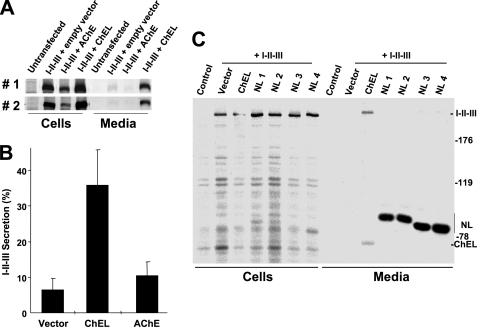FIGURE 8.
ChEL is unique in its ability to promote I-II-III secretion. A, in two independent transfections, 293 cells were co-transfected with the plasmids indicated at the top. The cells were pulse-labeled with 35S-amino acids for 30 min and chased for 4 h in complete medium. The cells were lysed and the media collected; both were immunoprecipitated with anti-Tg and analyzed by reducing SDS-PAGE and fluorography. B, from three experiments like those shown in panel A, secretion efficiency of I-II-III in the presence of empty vector, secretory ChEL, or AChE was quantified. C, 293 cells were co-transfected with plasmid expressing I-II-III and secretory FLAG-NL1, -NL2, -NL3, or -NL4 as indicated. Co-transfection with secretory ChEL was included as a positive control. The cells were pulse-labeled with 35S-amino acids for 30 min and chased for 4 h in complete medium. The cells were lysed, and the medium was collected; both were immunoprecipitated with a combination of anti-Tg plus anti-FLAG and analyzed by reducing SDS-PAGE and fluorography. As shown, secretory neuroligins could not rescue I-II-III secretion.

